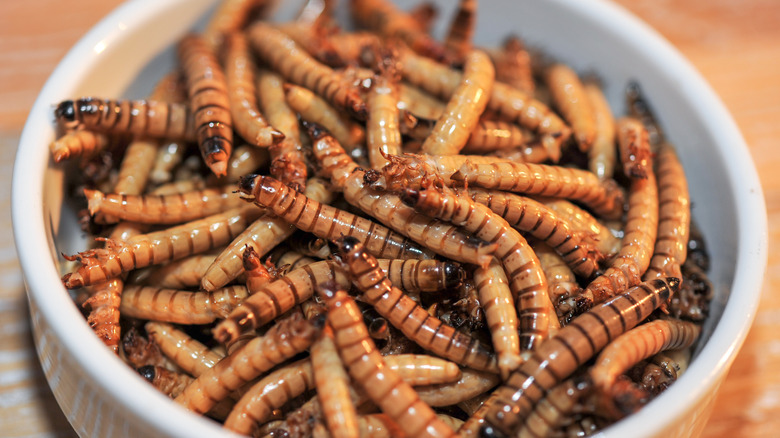Brian Malarkey Reveals The Strangest Item In His Fridge
Close your eyes ... and imagine what's on the shelves of your favorite chefs' refrigerators. You'd expect more than just a random bottle of ketchup and a mummified lime. Perhaps you'd find a bevy of extravagant, exotic items that home cooks can only dream of using. The truth is, whatever you're envisioning, you'd probably be surprised by the reality. Food Network asked some of its celebrities to divulge the oddest thing in their fridges, and Brian Malarkey's answer takes the cake.
Well, maybe you should read his answer before you start thinking too much about cake.
Malarkey told Food Network that he keeps chilled red mealworms on hand! The Guy's Grocery Games judge was quick to clarify that the mealworms were food for his children's fish, not part of a new recipe he's concocting. Given Malarkey's appreciation for the culinary arts, it is not surprising that the lucky family pets are treated to more than just dehydrated fish flakes — and apparently, they're quite happy with their fancy fare. Malarkey also jokingly indicated that his three kids have not tried the insects (or at least that they don't love mealworms as much as the fish do).
Brian Malarkey doesn't eat them, but are mealworms fit for human consumption?
Many people already consume insects in parts of Australia, New Zealand, and Africa. On the other hand, some people living in Europe or the U.S. seem less than enthused about the prospect of making that particular dietary transition, according to the Daily Mail. That may soon change, however, as the London newspaper reported that the European Safety Agency recently approved the crunchy creatures as a viable food source for humans.
Katharina Unger, a proponent of alternative protein, referred to mealworms in the Independent as "land shrimp," evolutionarily speaking — hoping to comfort those who think the wriggly bugs are disgusting. She added that they contain all the ideal qualities of plant and animal proteins. Mealworm Care says they can be enjoyed raw and alive, but suggests that dry-roasting is the optimal means of preparation, as they taste better, are less identifiable, and can be stored without refrigeration for up to a year.

